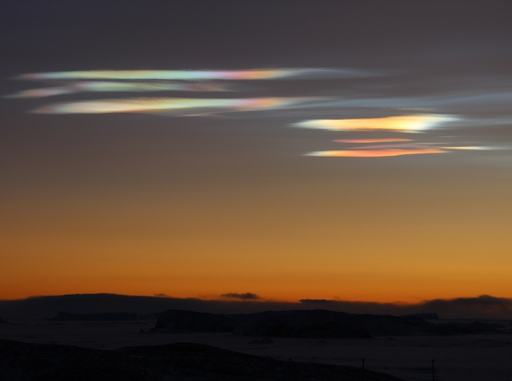POLAR STRATOSPHERIC CLOUDS: Bright colors have appeared in the skies over Antarctica--but it's not the aurora australis. Instead, pastel stratospheric clouds are floating over the frozen continent. B. Sudarsan Patro photographed the apparition on June 17th from the Bharati Indian Base Station:
"The clouds were absolutely stunning," says Patro. "It was really surprising and a new experience for all of us."
Atmospheric optics expert Les Cowley says "Bharati Station at 70 degrees south is just the place to get these wonderful filmy Polar Stratospheric Clouds (PSCs). Floating 9 to 16 miles high, they need stunningly-cold temperatures below -85 Celsius to form."
Sunlight shining through tiny ice particles ~10µm across produce the characteristic bright iridescent colors of PSCs by diffraction and interference. "More familiar tropospheric clouds can also shine with iridescent colours," says Cowley, "but never as vividly or memorably as PSCs.
RED SPRITES AND GREEN AIRGLOW: Thunderstorm season is underway in the northern hemisphere. That means astrophotographers should point their cameras above the clouds. Thomas Ashcraft did so on June 14th, and he captured two forms of space weather--red sprites and green airglow:
"A large jellyfish sprite appeared over a thunderstorm in the western Oklahoma panhandle last evening," says Ashcraft. "It was about three hundred miles away from my observatory."
Possibly triggered by cosmic rays, sprites are a form of upper atmospheric that reach up from the tops of thunderstorms toward the edge of space. Although sprites have been seen for at least a century, most scientists did not believe they existed until after 1989 when sprites were photographed by cameras onboard the space shuttle.
Possibly triggered by cosmic rays, sprites are a form of upper atmospheric that reach up from the tops of thunderstorms toward the edge of space. Although sprites have been seen for at least a century, most scientists did not believe they existed until after 1989 when sprites were photographed by cameras onboard the space shuttle.
The "jellyfish sprite" Ashcraft captured is backlit by a band of green airglow. Airglow surrounds our entire planet, fringing the top of the atmosphere with aurora-like color. Although airglow resembles the aurora borealis, its underlying physics is different. Airglow is caused by an assortment of chemical reactions in the upper atmosphere. Auroras, on the other hand, are ignited by gusts of solar wind. - From SpaceWeather

